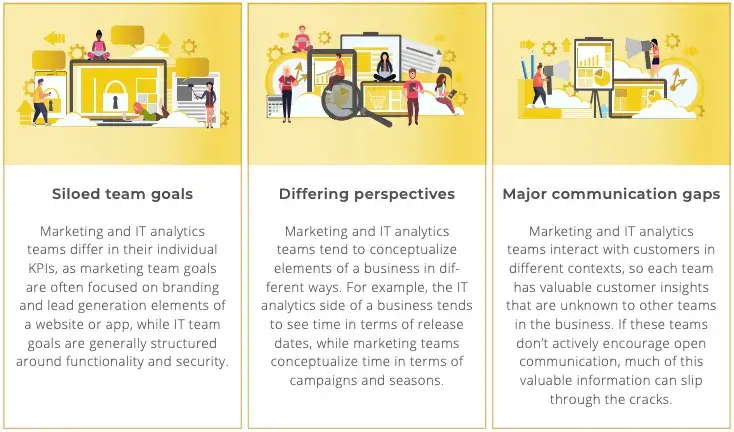In a perfect world, marketing and IT analytics teams would harmoniously collaborate to lift businesses to new levels of customer satisfaction and overall revenue.
But we don’t live in a perfect world, and in reality the relationship between marketing and IT analytics is often anything but harmonious.
In a recent webinar with Jim Cain, CEO and Founder of the analytics consultancy Napkyn Analytics, Jim indicated that nearly every one of Napkyn’s consulting clients struggles with creating synergy and alignment between marketing and IT analytics teams.
Undoubtedly, this is a pervasive issue for many analytics-driven businesses. But does it have to be that way? We don’t think so.
There are solutions to the discord (we present 4 in this eBook). But first, let’s take a quick look at where the discord stems from.
What causes misalignment between marketing and IT analytics teams?
As marketing analytics becomes an increasingly important element in business, IT analytics and marketing teams have had to collaborate more than ever. However, several issues get in the way, such as:

The challenges are there, so what is the solution? How can you improve the alignment of your marketing and IT analytics teams?
Aligning Marketing and IT Analytics Teams
Aligning your marketing and IT analytics teams may be a challenging task, but getting there is certainly possible. Jim, from Napkyn, illustrated that you can reach a point of more effective marketing and IT alignment through the following strategies:
- Aligning language, goals, and knowledge between teams
- Building a solid baseline for collaboration with the data layer
- Creating a framework that facilitates collaboration moving forward
- Focusing on necessary data
Let’s take a look into each of these strategies.
Align language, goals, and knowledge between teams
The first steps to aligning your marketing and IT analytics teams should be synchronizing the language used by the different teams.
Jim clarified that aligning this language requires leaders of each team to hold meetings specifically about language, and then work to unite each team on terminology around KPIs, goals, and terms for how each team conceptualizes different work elements, like what project completion looks like and which team owns specific tasks.
When IT analytics and marketing teams get on the same page by uniting on common terminology around these KPIs, goals, and workflow items, the two teams close communication gaps and effectively improve collaboration.
Increasing collaboration is one of the ultimate goals, as each team has valuable knowledge about the customer that may never get to other teams without collaboration. Failing to communicate this individual knowledge ends up negatively impacting the end user and the business’s bottom line.
Without effective communication and collaboration, each team will likely end up serving its own team’s goals, which may conflict with other teams’ goals.
Build a solid baseline for collaboration with the data layer
In the ObservePoint webinar, Jim Cain also spoke at length about how the data layer is the foundation for continuous collaboration between marketing and IT analytics teams.
Having an accurate and effective data layer allows teams to more easily collaborate on future tagging plans, while also helping marketing teams feel empowered to proficiently use their tag manager. As a result, a significant portion of resources should be spent on creating an accurate data layer.
Additionally, this baseline needs to involve creating space for each team to do their work properly. According to Jim, from Napkyn, marketing needs to allow IT to complete their work without trying to enforce timelines that are unreasonable, and IT should work to have specific marketing-dependent IT projects completed on time. Articulating these clear expectations will allow for improved communication while eliminating excess conflict.
Create a framework that facilitates collaboration moving forward
Creating a framework that ensures ongoing collaboration is essential to maintaining alignment and can only be done by implementing processes that support collaboration.
Collaborative processes need to involve rigorous tracking of each team’s tasks and accomplishments in relation to one another, so the teams can ensure accurate communication into the future.
The processes should also require teams to review work and ensure quality, leading to the website breaking less often, which can have a negative effect on relationships. According to Jim Cain from Napkyn Analytics, “Things breaking on the site lead to relationships breaking down in the office.”
Building a Framework on the Foundation of Analytics Test Automation
One great way to ensure quality between IT analytics and marketing teams is through site audits with automated testing software. Running automated audits will allow you to obtain a clear, third-party view of your analytics implementation and ensure communication about your implementation remains intact.
ObservePoint provides you with automated software that allows you to thoroughly audit your site and monitor your analytics implementation over time. These site audits are profoundly helpful when ensuring the quality of your analytics implementation and when communicating site expectations with other teams.
Focus on necessary data
One crucial element to getting marketing and IT analytics teams aligned is focusing only on necessary data, as there is often an unhealthy tendency for marketing teams to collect excess amounts of data in an effort to not miss any data.
Why is excess data a problem? Collecting excess data bogs you down. Having too much data can slow down decision-making, frustrate IT analytics teams with useless data, and create bottlenecks for digital release cycles.
As a result, both marketing and IT analytics teams need to move their focus to only collecting data that is directly related to improving customer experiences, because that’s the data that will ultimately impact the company’s bottom line.
Use Team Alignment to Improve Customer Experiences
At the end of the day, your efforts to align teams should be about delivering amazing experiences to your customers.
Increasing alignment between marketing and IT analytics teams will allow you to remain customer-obsessed and deliver customized experiences based on accurate data and insights. These improved customer experiences will continuously increase loyalty and steer your bottom line upwards.
ObservePoint is here to help. To see how ObservePoint can help you align your marketing and IT analytics teams via automated analytics validation, schedule a demo.





